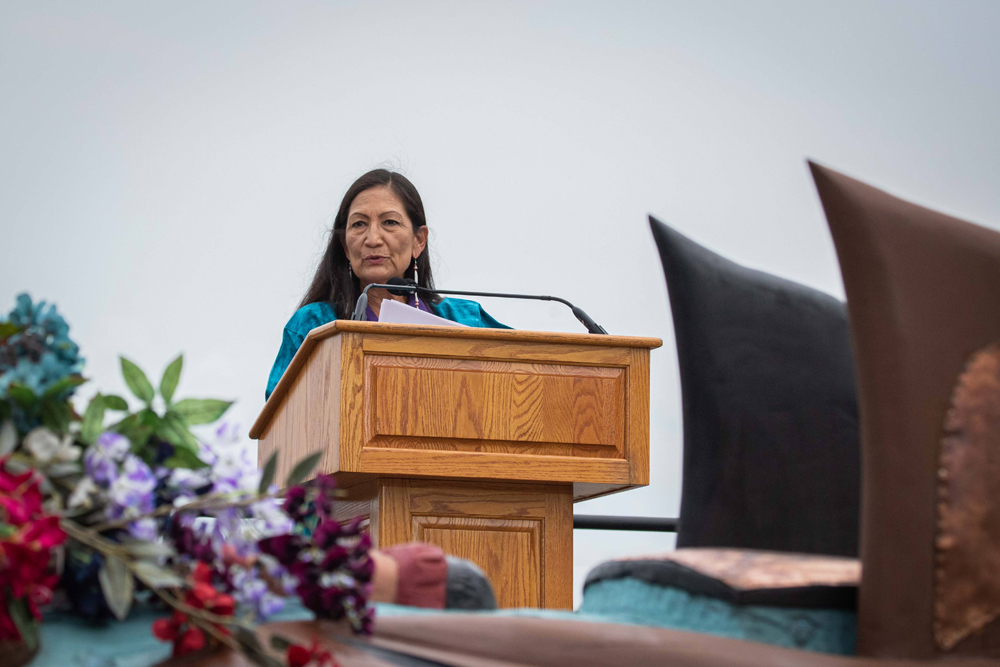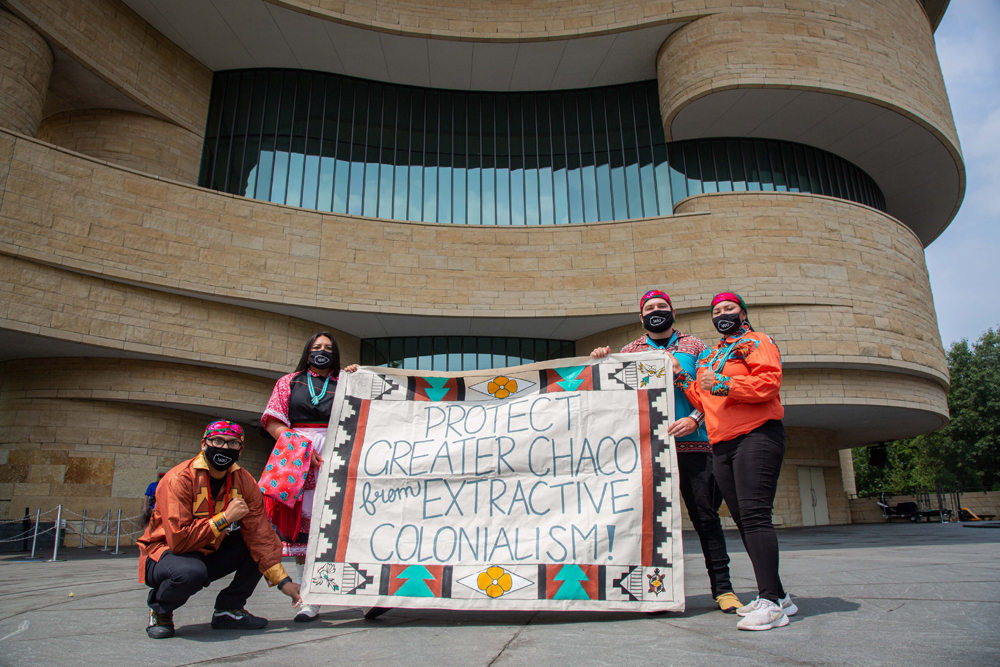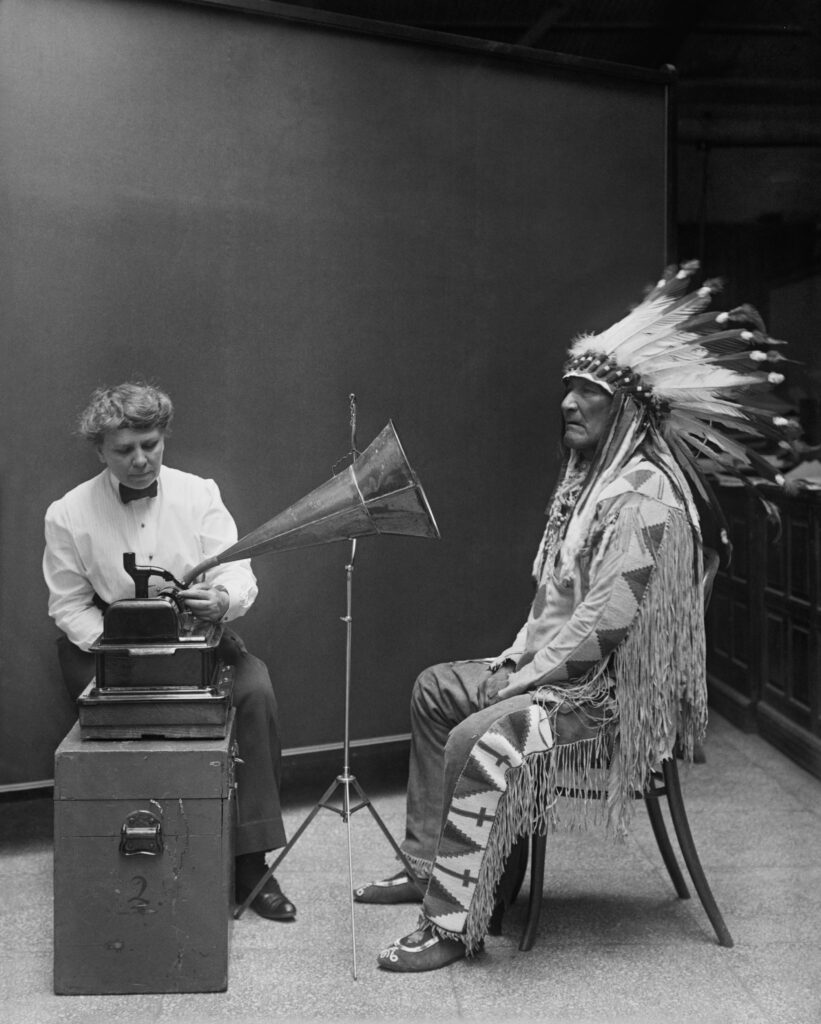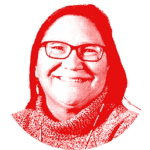Rosalyn LaPier (Blackfeet/Métis) is an environmental historian and traditional ecological knowledge practitioner. In addition to her role as Professor of Environmental History at the University of Illinois at Urbana-Champaign, she works with Saokio Heritage, a community-based organization on the Blackfeet Reservation that is working to revitalize traditional ecological knowledge and practices, as well as to revitalize the Indigenous languages that are embedded in and with traditional knowledge. In this interview with The Natural History Museum’s Steve Lyons, LaPier discusses the lasting impacts of the US government’s century-long effort to exterminate the culture, language, and religion of her ancestors, as well as the role that she and other Indigenous knowledge keepers are playing in response.
Steve Lyons (SL) You just published a powerful essay on the history of Native boarding schools in response to President Biden’s official apology for the atrocities committed in these institutions. What are the problems with, limitations of, or even dangers of accepting this kind of symbolic gesture, which reflects what Glen Sean Coulthard calls the “politics of recognition,” a political project that manifests in different countries as truth and reconciliation, land acknowledgments, and so on?
Rosalyn LaPier (RL) In the Fall of 2024, President Biden and Secretary of the Interior Deb Haaland offered an apology to Native American tribes and Native American communities for the atrocities that occurred as part of the Native American boarding school policies. When Haaland was appointed as Secretary of the Interior, she set out to investigate her own agency, the Department of Interior, and to pressure it to acknowledge the harm it has caused. As part of this inquiry, she asked the President for a formal apology.

Biden’s recent apology addressed the abuses that occurred in Indian boarding schools—physical abuse, mental abuse, sexual abuse. He said that this was one of the horrific chapters in American history. But while this was a historic gesture (in fact, acting Presidents have only apologized for policies towards Native Americans a few times), it was striking to me that neither the President, nor Secretary Haaland used the word “genocide” to describe the boarding school policies. By removing children from their families without consent and taking them to institutions designed to erase their traditional cultural practices, languages, and religions, the US government committed genocide. Numerous historians and other scholars have demonstrated that these schools did not exist to educate children. They existed to erase Indigenousness out of people. This is the definition of genocide.
SL If President Biden was to include the language of genocide in his apology, would this expose the United States to scrutiny, either from the international courts or from Native communities? Would it leave the government more vulnerable to demands for action? And if the US government was to act, what kinds of action would you like to see?
RL One of the reasons that the United States government does not use the word genocide to describe what happened at the Indian boarding schools is this would set the government up for legal action against it, both internally within the United States, and internationally, where it could be taken to international court. Politicians stay clear of that kind of language because they know that certain words can lead to legal action.
Having said this, what would I like to see out of Biden’s apology? We could start with funding. Oftentimes, when tribes ask the government for funding, they are offered competitive grant funding. What this means is that in order to get funding for revitalizing Indigenous languages, for example, Native Nations will find themselves competing against each other, against NGOs, and against universities. I think that to begin to apologize for its genocidal policies, the United States government should start by providing noncompetitive funding to any tribe that wants funding to revitalize the languages that the boarding schools aimed to exterminate.
The United States government also needs to address the cultural practices that were lost while children were at Indian boarding schools. Beyond language revitalization, I believe the United States should provide noncompetitive funding to support everything from food sovereignty to religious practice to daily life, where a variety of customs and ways of interacting with family and community were lost.
The other thing that needs to be addressed is what people are calling “intergenerational loss.” There are a lot of socioeconomic issues that exist within tribal communities because of the impact of Indian boarding schools—issues that stem from children not knowing how to parent their own children, children who grew up in physical violence now acting out with physical violence, children who grew up with sexual violence now acting out with sexual violence in their own communities.
SL At the same time as we can criticize Biden’s half-measure, there is something really important in, at the very least, not forgetting. In your work, you emphasize the importance of intergenerational knowledge for the survival and resurgence of Indigenous cultures that have undergone centuries of extermination and assimilation campaigns, all designed to break the generational links that tie Indigenous people to the ways and worldviews of their ancestors. Why does maintaining intergenerational knowledge matter? Perhaps we can discuss this in reference to the teachings in ethnobotany that were passed down to you. Why was it important for you to learn about Native plants and ethnobotany, and does the knowledge you now possess oblige you to pass it on to the next generation?
RL Multiple generations of my own family attended Indian boarding schools, but despite this, my family was very fortunate. This is because my grandparents grew up in communities and in families where our Native language, the Blackfeet language, was their first language. They came from families that participated and practiced Blackfeet religion. And they also were from families that were what we’d call today “knowledge keepers.” For example, my grandmother was trained to be a “doctor” within our own community. Because of this, I grew up in a family with a lot of knowledge, a lot of religious knowledge and a lot of language. Because we had that foundation, my family was able to continue to share its knowledge of Blackfeet language, religion, and plants with the next generations, even though they were impacted by the legacy of Indian boarding schools. It wasn’t until later in life that I realized that this was definitely not true for a lot of people.

I was fortunate to be able to apprentice with my grandmother and my oldest aunt to learn about ethnobotany and the traditional ecological knowledge of the Blackfeet. So I’m able to now share these teachings with other younger generations. Over the years, as I have done workshops in the community and taught young adults at university, I have found that at some point in young Indigenous people’s self-awareness, they realize that they were born into a colonial system. They realize that they are colonized people, inheriting a long history of land annexation, land removal, and deportation. They learn that the reason they don’t speak their own language is because their language was removed from their family at the boarding schools. They realize that they don’t know about the cosmology or the religion of their own community because of a colonial loss that occurred over time. They also begin to realize that they’re part of a capitalist society. When these things come together, young people wake up and are literally like, “what the heck?” How did this happen? Why was I born into this system of colonization and genocide? This comes as a shock to many young people, who become really angry when they realize what has happened to themselves, their parents, and their families. They are not only angry—they want to push back.
Increasingly, I’m beginning to see the emergence of a revolutionary mindset among young people, who are not just interested in learning about plants, but learning about plants to figure out how we can separate ourselves from the United States. There are young people who think that we should not be part of the United States. Understanding themselves as a colonized people, they start to see similarities between themselves and other Indigenous people around the world, who are also occupied, whose land is also being annexed, and who are experiencing the same kinds of historic atrocities that happened to their own people. They recognize that they need to do something, they need to change the world that they’re in, and they need to take a step towards revitalizing a lot of things in their own community so that they can be future leaders as our situation evolves in the United States.

SL It is amazing to hear about what this kind of teaching can do to unleash this revolutionary consciousness among young people. For Indigenous people in North America to be able to see themselves in the Palestinian people who are under siege right now, and to see the echoes of the extermination campaigns that their ancestors went through in the ongoing extermination campaign being waged on Gaza is precisely what can make solidarity possible.
Your essay for our Red Natural History essay series engages the experiences of Indigenous scholars and communities whose practices of recovery and knowledge regeneration either rely on or can be enriched by documents and objects that are held in archives and museums of natural history. I’m wondering if you could shed light on how these collections came to be. Under what terms did museums and archives come to “acquire” so many important and sacred cultural objects from Indigenous Nations across the continent (and the world)? And what did these acquisitions seek to accomplish?
RL As I was on my own personal journey to learn more about my own community, I was working for a Native language revitalization organization on the Blackfeet Reservation. One of the founders of that organization encouraged me to learn everything I could about my own Tribe. This struck a chord with me. I thought, he’s right—we should be learning everything about our own Tribe, instead of relying on outside scholars as the “experts” about our own communities. As I mentioned earlier, because I was blessed to have come from a family that already had a lot of knowledge, I had a foundation. But then I decided to look at what had been collected in the past—stories, songs, religious knowledge. I wanted to understand how this information had been collected and by whom. This led me to natural history museums, where such collections tend to exist. I went to the American Museum of Natural History (AMNH) in New York and the Smithsonian National Museum of Natural History (SNMNH) in Washington, D.C.
I should start by saying that there is a really interesting mixture of objects and information in natural history museums. There are stories, songs, and material objects that indigenous people intentionally left behind, and things that were literally stolen by collectors. All of this was written down because most natural history museums are very good at documenting what they have. They have ledger books that list everything that came in and how much they paid, down to the nickel.

As I explored the collections of the AMNH and SNMNH, I was interested in the question of agency, in what Indigenous people chose to leave behind. When the early ethnographers and collectors came to Tribal communities to collect information, they would ask the questions, but this did not mean that their so-called “informants” had to answer. At least for my own Tribe, the people who were interviewed in the nineteenth and early twentieth centuries overwhelmingly wanted to talk about religion and religious practice. They wanted to discuss how we think about the world that we live in, how we think about the universe and our relationship to the natural world.
They could have talked about genocide, massacres, and land annexation. And they did talk about those things with the policymakers in Washington, D.C. But when they were being recorded for natural history by ethnologists, they overwhelmingly left behind testimony about their relationship with the universe. They thought that these stories were extremely important to share for future generations.
The flip side of this story of Indigenous agency is much darker. We know that at the same time as they were collecting information about tribes, many natural history museums were also illegally digging up human remains and the funerary objects buried with them. When you’re doing research in a natural history museum, you never know what’s going to be on the next page or in the next folder. On one page you will be reading a story that your grandparents had voluntarily told. On the next, you will be confronted with information about stolen human remains. As a community member, but also as a scholar, you have to prepare yourself for this kind of shock.
SL Your latest book engages with the way of seeing and understanding the world that oriented your Blackfeet ancestors before and during the early years of colonization. You specify that in the Blackfeet cosmology, “humans did not have any supernatural power of and by themselves. Instead they needed to seek out supernatural power from those beings who had it. The Blackfeet believed that humans had to create alliances with the supernatural to live life to the fullest.” Can you tell us what kind of message, obligations, or ethical relationship to the land, water, and air follow from the cosmology you unpack in the book?
RL As part of their cosmology, as part of their worldview and as part of their religion, the Blackfeet believed that humans did not themselves have any supernatural ability. But there were deities, monsters, animals, plants, and other entities out there in the world with supernatural powers that we could tap into. Within the Blackfeet worldview, there was a certain sense of individuality. People did not have to be religious if they didn’t want to be. People did not have to create alliances with the supernatural realm if they didn’t want to. But if you were a human, you would have a fuller and richer life if you created relationships not just with other humans, but with other entities that existed within our universe. Because of that, it was extremely important in the Blackfeet worldview to create as many good relationships as you possibly could—not just with humans, not just with your family, not just with your community, but also with the supernatural realm. And you had to maintain those relationships.
We might think about the way we think of friendship today. Many of us try our best to have good relationships with our friends and family, so we do things to maintain those relationships. We take people out to coffee. We go to dinner. We go together to the museum or the movies. Now think about supernatural entities. Native people had to create relationships with a lot of different supernatural entities over the course of their lifetimes and to maintain their relationships with all of those entities. In the same way that humans maintain relationships with other humans, the Blackfeet maintained relationships with supernatural entities who could help us when we needed help in the same way that humans help us when we need help.
For the most part, the Blackfeet believed that they did not have to “suffer” what was occurring in the natural world. If the wind was too windy, you could stop the wind from blowing. If there was too much rain, you could stop the rain from raining. If there was too much snow, you could stop the snow. If you wanted more sunlight, you could get more sunlight. They believed that you could change everything by having a relationship with a supernatural entity who could help you change it.
I am really fascinated by the confidence that the Blackfeet had—this idea that they could literally walk out their door and change it all because they maintained good relationships with the supernatural realm. And there are many stories from the past, even within my own family, of people who could control the natural world to benefit their family, their community, and to live a whole and rich life.
SL One of the things I’ve noticed is how when you speak about the Blackfeet, you’re speaking in the past tense. This makes me think of a quote from L.P. Hartley that I’ve seen you refer to in several different texts: “the past is a foreign country.” What does it mean in your work to engage the past as a foreign country? And do you think engaging with the foreignness of the past can teach us things about our present?
RL When I started going to libraries, archives and natural history museums, I was really interested in understanding the world that my grandparents grew up in, as well as the world they were born into. My grandmother was born in 1914. My grandfather was born in 1911. My question was: what did the world of the Blackfeet look like in 1910? When I looked back at that time, it was a foreign country to me. Everybody spoke the Blackfeet language. Everybody practiced the Blackfeet religion, even though they had been on the reservation now for 25 years—an entire generation. It was a completely different place to the reservation I know. In a sense, it was like traveling across the world and going to a completely different country where everybody spoke a different language, practiced different cultural practices, had a different religion, and ate different food than on the reservation that I was literally standing in. The opposite would be true for my grandparents if they were to return today.
My grandmother lived to be 97, so she did live into the twenty-first century, and by the end of her life, she felt as dislocated in our world as I would have felt in hers. We spoke a different language. We had different cultural practices. Most of us were either not practicing any kind of religion or were Christians. And we ate completely different food. Our present was a foreign country to her.
Sometimes people try to think of Tribal communities as static and unchanging, but this is not true at all. The world that we live in is a world that has been colonized and profoundly impacted by land annexation, land removal, deportation, and genocide. The world my grandparents grew up in was actively being colonized, but it still retained many of the attributes of their own Blackfeet life, world and culture. This difference matters. It is important to allow a place to be its own place, and to resist the temptation to superimpose our 21st century ideas or our own personal experience in our tribal communities back onto earlier times.
SL It occurs to me that if we understand the past as a foreign country, learning how people saw the world in the past might help us see the present as a foreign country–and thus to denaturalize habits of thought that make capitalist relations between people, and between people and their environments, seem totally natural. This is, in a sense, one of the gambits of what we have been calling “red natural history.” We’re bringing together people who are fashioning tools or drawing on resources that can train us to see the world beyond and beneath the world as it has been ordered by imperialism. You have been involved with this project for a couple of years now, so I wanted to ask: What is “red natural history” to you, and what might it offer us in the present?
RL I want to start with the key word in “red natural history”—”red.” For the Blackfeet people, as well as for other Indigenous tribes, red is often thought of as a sacred color. For us, the color red is attached to a deity called Natosi, one of the three main kinds of deities that exist in our Blackfeet cosmology. Natosi lives in the sky realm. When Blackfeet people participate in religion and religious practices, they often paint their face or hands red, or they wear red clothing, or they put red on their moccasins to represent this deity. For me, the “red” of “red natural history” is filled with this reference.
Red natural history presents an opportunity for us to reclaim and revitalize a lot of things—from the word “natural history” to the institutions that support the study of the natural world. From time immemorial, Indigenous people have developed relationships with the natural world, as well as scientific knowledge about the natural world—the kinds of observations and insights that natural history museums were built to collect, but that were never taken seriously alongside the observations and insights of Western science.
I don’t want “natural history” to be a term that only Western science can use. I want Indigenous people to be able to claim it as their own, and I want Indigenous people to claim it as something that we’ve been doing for a very long time. To me, the project of “red natural history” enables us to bring our own Indigenous science to the table, to define and debate what it means for us, but also what it means for the entire world. As we go through the crises we’re facing today, including the global climate crisis, Indigenous science has insights that should not only be shared, but also implemented by people around the world.
 Rosalyn LaPier (Blackfeet/Métis) is an award winning writer, ethnobotanist, environmental activist and Professor of History at University of Illinois Urbana-Champaign. She/they work within Indigenous communities to revitalize Indigenous & traditional ecological knowledge (TEK), to address environmental justice & the climate crisis, and to strengthen public policy for Indigenous languages. The author of Invisible Reality: Storytellers, Storytakers and the Supernatural World of the Blackfeet (2017), she/they are a 2023-2025 Red Natural History Fellow. Rosalyn is an enrolled member of the Blackfeet Tribe of Montana and Métis.
Rosalyn LaPier (Blackfeet/Métis) is an award winning writer, ethnobotanist, environmental activist and Professor of History at University of Illinois Urbana-Champaign. She/they work within Indigenous communities to revitalize Indigenous & traditional ecological knowledge (TEK), to address environmental justice & the climate crisis, and to strengthen public policy for Indigenous languages. The author of Invisible Reality: Storytellers, Storytakers and the Supernatural World of the Blackfeet (2017), she/they are a 2023-2025 Red Natural History Fellow. Rosalyn is an enrolled member of the Blackfeet Tribe of Montana and Métis.
